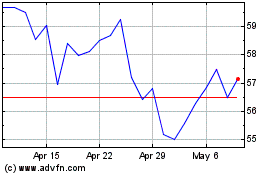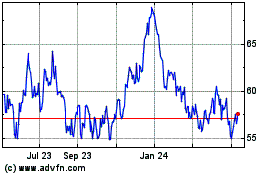BHP Chairman To Resign, Ending A Rocky Tenure -- WSJ
October 21 2016 - 3:03AM
Dow Jones News
Jac Nasser, who joined board of mining giant in 2006, won't seek
re-election next year
By Scott Patterson
LONDON -- BHP Billiton Ltd. Chairman Jac Nasser plans to step
down from the mining giant, ending a tumultuous six-year run during
which he replaced a chief executive, cut its dividend and struggled
with an environmental disaster in Brazil.
Mr. Nasser told shareholders on Thursday he wouldn't seek
re-election as its chairman at next year's general meeting. The
former CEO of Ford Motor Co. said he had planned to announce his
retirement last year but decided to stay due to the tailings dam
disaster at its Brazilian joint venture Samarco, which it operates
with Vale SA, the Brazilian iron-ore giant.
"Now that the basic structure of the Samarco response is in
place...I have decided that I will not seek re-election" next year,
he said.
Mr. Nasser joined the board in 2006 and became BHP's chairman in
2010 at the height of a global commodities boom driven by voracious
demand in China. It ends amid the fallout of the collapse of the
boom, which has ravaged the stocks of miners such as BHP and
competitors such as Rio Tinto PLC, Anglo American PLC and Glencore
PLC.
While shares in mining companies have rebounded this year amid
signs of renewed appetite in China, they largely remain well below
the peaks they hit about five years ago. When Mr. Nasser joined
BHP, the mining industry, flush with cash, was in the midst of a
rapid expansion and voracious merger boom that ballooned miners'
balance sheets with debt.
In 2010, the same year Mr. Nasser become chairman of the
company, BHP launched a hostile campaign to take over Canadian
potash titan Potash Corp. of Saskatchewan Inc. Led by BHP's
then-CEO Marius Kloppers, the $38.6 billion takeover battle, seen
as one of the most contentious hostile bids in years, failed amid
opposition from the Canadian government.
Three year later, Mr. Nasser replaced Mr. Kloppers with BHP's
current chief, Andrew Mackenzie, then head of the miner's
nonferrous-metals division.
BHP didn't say who it expects to nominate as chairman to replace
Mr. Nasser; he also plans to leave the company's board.
BHP, along with other miners, saw its earnings sag in recent
years during a bust in demand for commodities, including the
high-grade iron ore that accounts for a large chunk of BHP's sales.
But BHP was seen by Wall Street as among the most resilient miners,
due to its portfolio of low-cost iron-ore operations in
Australia.
Buoyed by its iron-ore profits, the company vowed it would
maintain its progressive dividend. When asked in August 2015
whether BHP would contemplate a dividend cut, Mr. Mackenzie told
analysts: "Over my dead body sounds a little strong, but it is
almost right."
But in February, BHP slashed its dividend after recording a
$5.67 billion first half loss due in part to a massive write down
of its U.S. energy assets. Mr. Nasser at the time said the company
now believed "the period of weaker prices and higher volatility
will be prolonged."
Much of Mr. Nasser's time in the past year has been spent
dealing with the Samarco tailings dam disaster, which killed 19
people and saddled BHP and Vale with billions in reparations
payments. He said Thursday that the past year has been "one of the
most challenging periods in the long history" of BHP, "none more
serious than Samarco."
"We are deeply sorry for all those impacted by this tragedy," he
said. Mr. Mackenzie said Thursday that the Samarco disaster has
"left a deep scar on our company."
Write to Scott Patterson at scott.patterson@wsj.com
(END) Dow Jones Newswires
October 21, 2016 02:48 ET (06:48 GMT)
Copyright (c) 2016 Dow Jones & Company, Inc.
BHP (NYSE:BHP)
Historical Stock Chart
From Mar 2024 to Apr 2024

BHP (NYSE:BHP)
Historical Stock Chart
From Apr 2023 to Apr 2024
